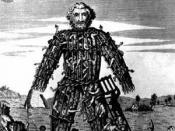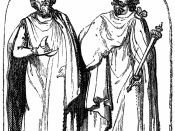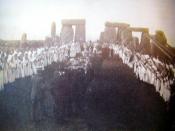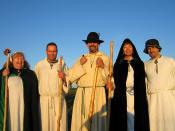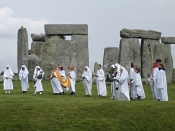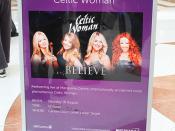Benson 6
I intend to show how Druids were an integral part of ancient Celtic culture. When one hears the word "Druid", many images come to mind. One could think of Stonehenge, long flowing white robes, and shadowed faces. It may surprise someone to hear that Druids were healers. Druids were many things to the ancient Celts. Druids were philosophers who sought the "truth" for their people. Even though Druids are a part of history, they serve as historians to their people. For fun and merriment there was a special class of Druids called Bards. Druids were an integral part of Celtic religion. Also, druids were masters' of auguries and astronomy.
The ancient Celts were one of the first societies to appear in the north, above the Alps. They were called the Keltoi by the Greeks. Keltoi or Celit is an Irish word meaning secret or hidden. The Celts passed down their knowledge orally; they did not start writing their history untill the Christian era.
"In trying to understand Celtic motivations, their attitudes, philosophies and laws, we are handicapped by the early prohibition of the Celts against committing their knowledge to written record" (Ellis 13). The Celts were a tribal society of farmers. They had metal working skills not only used for farming, but weapons. They crafted beautiful jewelry and pottery. They had a complex code of tribal laws that were overseen by the Druids. Two warring Celtic tribes could have their weapons out, ready to fight, and a Druid could march in, raise their hands and all fighting would cease immediately. That was the power of the Druids.
Druids were the aristocracy of the Celtic people. To become a Druid one must apprentice at a Druidic schools. Unfortunately, there is some debate over when one of these Druidic apprenticeships began. The first theory is that children started at a young age learning the Druidic path and graduated when they were twenty. The second theory is that apprenticeships started at twenty and graduated at forty. Druids were the only instructed and educated of the ancient Celts. "They were adviser to kings, influenced and often took precedence even over the kings, being held in great respect" (Ellis 80).
Unlike other civilizations at that time, women had authority and could be Dryades, female Druids, or Druidesses. In Rome or Greece women could not escape the patriarchal society in which they lived. Ancient Celtic women had all the same rights as men. They could receive land, hold positions in government, and fight wars. One of the most famous Druidesses is Boudicca, who led an uprising against Rome.
Druids were great healers. In Welsh and Irish mythology male and female Druids appeared time and again to cure the sick. Druids knew many different herbs and their uses. In Irish mythology Goll Mac Morna and Furbaide were delivered by caesarian section preformed by a Druid. The medical knowledge of the Druids is also shown by "The Ovingdean Trephined Skull" (Ellis 212). This skull was found with two holes drilled into it on different areas. The skull also shows that the holes mended themselves somewhat, but that the person died for some other reason. The fact still remains that this pre-Christen era human had major head surgery performed twice and lived for a time.
Druid philosophy encompassed a myriad of spiritual ideas. Druids taught that one should revere nature. Instead of seeing perceived evils, such as death, one should accept them as spiritual growth. Death to a Druid was not an ending, nor was birth a beginning. Druids believed and taught their concept of Karma. When one died in this world they were born into the otherworld. Consequently, when one died in the other world they were born into this world. "Thus a constant exchange of souls took place between the two worlds" (Ellis 176).
Druidic historians were keepers of the myths, legends, traditions, and genealogies. It was very important to ancient Celtic culture for the Druids to remember all this knowledge because none of this information was written down. Druids did not start to "transmitted into written form by the fifth centaury" (Ellis 204). One of the reasons that Druidic historians did not write down much of their history was that they served powerful kings. Kings that would need wisdom from previous battles fought with the enemy. Druidic historians kept genealogies of those in power.
Some Druids called Bards specialized in music, poetry, and dance. Bards would sing various songs and would play musical instruments, not just to entertain but to tell stories. Celtic people loved poetry. Some poetry was incorporated with Celtic mythology. The Celtic people also had a number of musical instruments they could play including "lyres, drums and pipes" (Ellis 210).
Druids could perform auguries or had the ability to tell the future. Performing these rituals for Druids was not easy. Druids did use human sacrifice. The intestines, kidneys, and lungs of the sacrificed individual could be interpreted as messages from the gods. Druids would interpret the message from the gods depending on how the innards looked. Druids also preformed animal sacrifice and used the same method of reading the innards of the animal. Druids also watched birds for signs and omens, interpreted dreams, and used "Ogham Sticks" (Ellis 224). Ogham Sticks were sticks of wood from a sacred tree, oak or yew, and inscribed with the Ogham, better know as runes. The Ogham sticks were thrown down and interpreted on how they were positioned.
The Druids were exceptional masters of Astronomy and Astrology. Astronomy and Astrology were considered the same discipline until the seventieth centaury. "One thing that pre-Christian Greek and Latin observers agreed uponâ¦is that the Druids were highly advanced in Astrology and Astronomy" (Ellis 228). The Druids had a complex calendar, in which their months and years did not depend on the number of days, but the nights and of the moon and star phases. One of the oldest and most interesting ancient devices that the druids built is the three tumuli of New Grange, Knowth, and Dowth. On the day of the winter solstice, when the sun is reborn, the innermost part of these structures is lit up by a perfectly aligned cut in the stone. The precision and calculation that these druids made so long ago still hold true today. One could go to Ireland and witness this amazing astronomical device and see the power of the Druids for him or herself.
I have shown how Druids were an integral part of ancient Celtic culture. The power of the Druids is still present and can be seen today in Stone Hedge and other structures that were built so long ago. Druids had a complex religion and philosophy which was based upon the natural world. They also have left behind traces of obscure and advanced healing methods that somehow were lost for generations. Druids were the only educated peoples in their society; with their oral traditions being committed to memory, they are shrouded in misinformation and mythology. Luckily, some of their Druidic teaching, poetry, and music have survived for today's historians to guess and ponder on. This author believes that these legendary historic figures would have it no other way.
Works Cited
Ellis, Peter. The Druids. First. Grand Rapids, Michigan: Wm. B. Eerdmans Publishing Co., 1995.
Ellis, Peter. The Celtic Empire: The First Millennium of Celtic History. First. Duham, NC: Carolina Academic Press, 1990.
